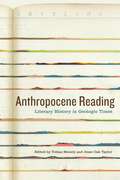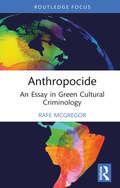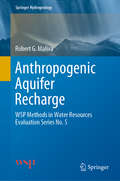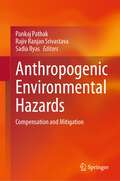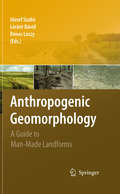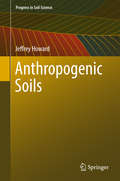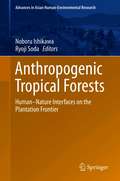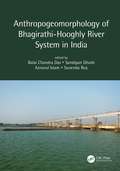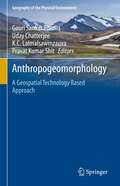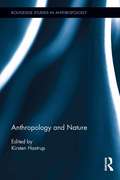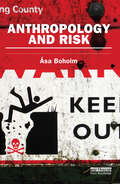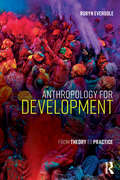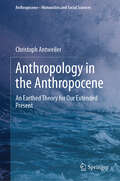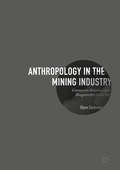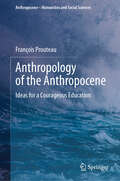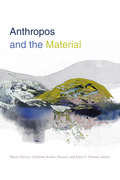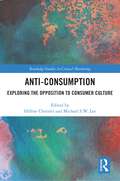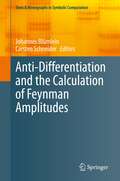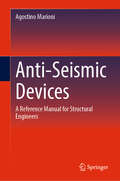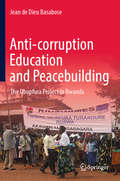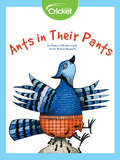- Table View
- List View
Anthropocene Reading: Literary History in Geologic Times (AnthropoScene)
by Steve Mentz Dana Luciano Jeffrey Jerome Cohen Jennifer Wenzel Benjamin Morgan Thomas H. Ford Stephanie LeMenager Justin Neuman Juliana Chow Noah Heringman Matt Hooley Derek Woods Anne-Lise FrançoisFew terms have garnered more attention recently in the sciences, humanities, and public sphere than the Anthropocene, the proposed epoch in which a human “signature” appears in the lithostratigraphic record. Anthropocene Reading considers the implications of this concept for literary history and critical method.Entering into conversation with geologists and geographers, this volume reinterprets the cultural past in relation to the anthropogenic transformation of the Earth system while showcasing how literary analysis may help us conceptualize this geohistorical event. The contributors examine how a range of literary texts, from The Tempest to contemporary dystopian novels to the poetry of Emily Dickinson, mediate the convergence of the social institutions, energy regimes, and planetary systems that support the reproduction of life. They explore the long-standing dialogue between imaginative literature and the earth sciences and show how scientists, novelists, and poets represent intersections of geological and human timescales, the deep past and a posthuman future, political exigency and the carbon cycle.Accessibly written and representing a range of methodological perspectives, the essays in this volume consider what it means to read literary history in the Anthropocene.Contributors include Juliana Chow, Jeffrey Jerome Cohen, Thomas H. Ford, Anne-Lise François, Noah Heringman, Matt Hooley, Stephanie LeMenager, Dana Luciano, Steve Mentz, Benjamin Morgan, Justin Neuman, Jennifer Wenzel, and Derek Woods.
Anthropocene Reading: Literary History in Geologic Times (AnthropoScene: The SLSA Book Series #1)
by Tobias Menely Jesse Oak TaylorFew terms have garnered more attention recently in the sciences, humanities, and public sphere than the Anthropocene, the proposed epoch in which a human “signature” appears in the lithostratigraphic record. Anthropocene Reading considers the implications of this concept for literary history and critical method.Entering into conversation with geologists and geographers, this volume reinterprets the cultural past in relation to the anthropogenic transformation of the Earth system while showcasing how literary analysis may help us conceptualize this geohistorical event. The contributors examine how a range of literary texts, from The Tempest to contemporary dystopian novels to the poetry of Emily Dickinson, mediate the convergence of the social institutions, energy regimes, and planetary systems that support the reproduction of life. They explore the long-standing dialogue between imaginative literature and the earth sciences and show how scientists, novelists, and poets represent intersections of geological and human timescales, the deep past and a posthuman future, political exigency and the carbon cycle.Accessibly written and representing a range of methodological perspectives, the essays in this volume consider what it means to read literary history in the Anthropocene.Contributors include Juliana Chow, Jeffrey Jerome Cohen, Thomas H. Ford, Anne-Lise François, Noah Heringman, Matt Hooley, Stephanie LeMenager, Dana Luciano, Steve Mentz, Benjamin Morgan, Justin Neuman, Jennifer Wenzel, and Derek Woods.
Anthropocide: An Essay in Green Cultural Criminology (Routledge Studies in Crime, Culture and Media)
by Rafe McGregorThrough an examination of Alfonso Cuarón’s Children of Men, this book demonstrates the ability of cinematic fictions, and other complex narrative fictions, to contribute to meeting the climate challenge by shaping the desires of audiences. What if there was a single feature film that showed us everything we need to know about climate catastrophe culture? What if that same film also made the philosophies of Slavoj Žižek, Mark Fisher, Francis Fukuyama, and Fredric Jameson accessible? Identifying the climate challenge as a cultural challenge, this book provides an unprecedented criminological analysis of both Children of Men and Fisher’s oeuvre from 1998 to 2022 and demonstrates the capacity of cinematic narratives to shape climate catastrophe culture. Seeking to be part of the solution to the climate challenge, it is the first criminological study to link the capacity of cinematic fictions to shape desire to solutions to the climate crisis. It is also one of the most detailed and most rigorous criminological case studies of a cinematic work to date.Anthropocide: An Essay in Green Cultural Criminology will be of great interest to students and scholars of green criminology, cultural criminology, narrative criminology, film theory, philosophy of film, and ecocriticism.
Anthropogenic Aquifer Recharge: WSP Methods in Water Resources Evaluation Series No. 5 (Springer Hydrogeology)
by Robert G. MalivaThe book is an overview of the diversity of anthropogenic aquifer recharge (AAR) techniques that use aquifers to store and treat water. It focusses on the processes and the hydrogeological and geochemical factors that affect their performance. This book is written from an applied perspective with a focus of taking advantage of global historical experiences, both positive and negative, as a guide to future implementation. Most AAR techniques are now mature technologies in that they have been employed for some time, their scientific background is well understood, and their initial operational challenges and associated solutions have been identified. However, opportunities exist for improved implementation and some recently employed and potential future innovations are presented. AAR which includes managed aquifer recharge (MAR) is a very important area of water resources management and there is no recent books that specifically and comprehensively addresses the subject.
Anthropogenic Environmental Hazards: Compensation and Mitigation
by Sadia Ilyas Pankaj Pathak Rajiv Ranjan SrivastavaThis book delves into the anthropogenic activities responsible for environmental hazards, their compensation, and potential mitigation strategies. It sheds light on the major contributors to the climate change issues aggravated by non-sustainable practices for the overexploitation of natural resources. Critical topics such as high emissions in primary mining, the recovery of energy-critical metals by urban mining, solid waste management, and forest conservation are explored, offering insights into the urgent challenges we face.Amidst the rapid demand for resources and the expansion of human habitats, the book emphasizes the need for new approaches to natural resource management and introspection of our actions. Experts in the field discuss existing anthropogenic environmental hazards in detail, alongside environmental compensation, and effective mitigation approaches.The book begins with a chapter dedicated to risk assessment in primary mining activities for precious metals, proposing potential routes for mitigation. Chapter 2 focuses on assessing and mitigating the environmental footprints of energy-critical metals used in permanent magnets. In Chapter 3, a case study examines sustainable resource utilization through end-of-life room air conditioner recycling. Additional chapters provide critical insights into:The environmental impacts of e-waste and government policies for responsible managementHazards associated with industrial effluents and corresponding mitigation strategiesThe role of roadside plants in phytoremediation of heavy metal pollutionSustainable utilization of anthropogenic coal fly ash through mechanical and chemical activationEnvironmental damages resulting from the mismanagement of municipal solid wasteEnvironmental problems and remediation strategies for anthropogenic biomass wasteChallenges in sustainable municipal solid waste management and suggestions for environmental risk mitigation The book concludes with a chapter discussing collaborative governance and non-monetary compensation mechanisms for sustainable forest management. Given its breadth, this book serves as an indispensable resource for researchers, policymakers, and environmental professionals seeking sustainable approaches to tackle pressing environmental challenges.
Anthropogenic Geomorphology: A Guide to Man-Made Landforms
by Denes Loczy József Szabó Lóránt DávidAnthropogenic geomorphology studies society's impact on the geographical environment, and especially on the Earth's surface. This volume provides guidance to students discussing the basic topics of anthropogenic geomorphology. The chapters cover both its system, and its connections with other sciences, as well as the way the subject can contribute to tackling today's practical problems. The book represents all fields of geomorphology, giving an introduction to the diversity of the discipline through examples taken from a range of contexts and periods, and focusing on examples from Europe. It is no accident that anthropogenic geomorphology has been gaining ground within geomorphology itself. Its results advance not only the theoretical development of the science but can be applied directly to social and economic issues. Worldwide, anthropogenic geomorphology is an integral and expanding part of earth sciences curricula in higher education, making this a timely and relevant text.
Anthropogenic Soils (Progress in Soil Science)
by Jeffrey HowardThis book is a state-of-the-art review of the physical, chemical and mineralogical properties of anthropogenic soils, their genesis morphology and classification, geocultural setting, and strategies for reclamation, revitalization, use and management.
Anthropogenic Tropical Forests: Human–Nature Interfaces on the Plantation Frontier (Advances in Asian Human-Environmental Research)
by Noboru Ishikawa Ryoji SodaThe studies in this volume provide an ethnography of a plantation frontier in central Sarawak, Malaysian Borneo. Drawing on the expertise of both natural scientists and social scientists, the key focus is the process of commodification of nature that has turned the local landscape into anthropogenic tropical forests. Analysing the transformation of the space of mixed landscapes and multiethnic communities—driven by trade in forest products, logging and the cultivation of oil palm—the contributors explore the changing nature of the environment, multispecies interactions, and the metabolism between capitalism and nature. The project involved the collaboration of researchers specialising in anthropology, geography, Southeast Asian history, global history, area studies, political ecology, environmental economics, plant ecology, animal ecology, forest ecology, hydrology, ichthyology, geomorphology and life-cycle assessment.Collectively, the transdisciplinary research addresses a number of vital questions. How are material cycles and food webs altered as a result of large-scale land-use change? How have new commodity chains emerged while older ones have disappeared? What changes are associated with such shifts? What are the relationships among these three elements—commodity chains, material cycles and food webs? Attempts to answer these questions led the team to go beyond the dichotomy of society and nature as well as human and non-human. Rather, the research highlights complex relational entanglements of the two worlds, abruptly and forcibly connected by human-induced changes in an emergent and compelling resource frontier in maritime Southeast Asia.
Anthropogeomorphology of Bhagirathi-Hooghly River System in India
by Balai Chandra DasThe Bhagirathi-Hooghly Basin in India is one of the most densely populated regions in the world and is undergoing rapid transformation of its natural landscape induced by human interventions, such as mushrooming of dams and barrages, deforestation, and urbanization. Human activities and interventions on basin landforms and the processes that shape those landforms have accelerated at an alarming rate. This book uses spatio-temporal analysis to understand the major anthropogenic signatures on land use and land cover changes and the impact these activities have on the landforms and processes of the Bhagirathi-Hooghly River and its sub-basins. It answers the what, where, why, and how of the anthropogenic signatures involved. Recent case studies on the impact of anthropogenic signatures on fluvial forms and processes make this book a useful resource for students and researchers in the earth sciences, local governments, urban planners, and all concerned with rural developments. Features: Explores for the first time the new concept of anthropogeomorphology for the river basin—an emerging field Analyses the impact of anthropogenic activities, especially the construction of dams and reservoirs, and urbanization on major fluvial landscapes using advanced geospatial modelling techniques Investigates human interference in river systems, their effects on the dynamics of the river, and the livelihoods of the people residing along the river Addresses issues related to geology, geomorphology, geography, planning, land use, and land management areas Fills the need for data-driven governance and policy decisions for the future of urban-industrial growth in India.
Anthropogeomorphology: A Geospatial Technology Based Approach (Geography of the Physical Environment)
by Gouri Sankar Bhunia Pravat Kumar Shit Uday Chatterjee K. C. LalmalsawmzauvaThis book explores state-of-art techniques based on open-source software and statistical programming and modelling in modern geospatial applications, specifically focusing on recent trends in data mining techniques and robust modelling in Geomorphological, Hydrological, Bio-physical and Social activities. The book is organized into physical, mountainous, coastal, riverine, forest, urban and biological activities, with each chapter providing a review of the current knowledge in the focus area, and evaluating where future efforts should be directed. The text compiles a collection of recent developments and rigorous applications of Geospatial computational intelligence (e.g., artificial neural network, spatial interpolation, physical and environmental modelling and machine learning algorithms etc) in geomorphic processes from a team of expert contributors. The authors address the wide range of challenges and uncertainties in the study of earth system dynamics due to climate change, and complex anthropogenic interferences where spatial modelling may be applied in the risk assessment of vulnerable geomorphological landscapes. The book will act as a guide to find recent advancements in geospatial artificial intelligence techniques and its application to natural and social hazards. This information will be helpful for students, researchers, policy makers, environmentalists, planners involved in natural hazard and disaster management, NGOs, and government organizations.
Anthropology and Nature (Routledge Studies in Anthropology #14)
by Kirsten HastrupOn the basis of empirical studies, this book explores nature as an integral part of the social worlds conventionally studied by anthropologists. The book may be read as a form of scholarly "edgework," resisting institutional divisions and conceptual routines in the interest of exploring new modalities of anthropological knowledge making. The present interest in the natural world is partly a response to large-scale natural disasters and global climate change, and to a keen sense that nature matters matters to society at many levels, ranging from the microbiological and genetic framing of reproduction, over co-species development, to macro-ecological changes of weather and climate. Given that the human footprint is now conspicuous across the entire globe, in the oceans as well as in the atmosphere, it is difficult to claim that nature is what is given and permanent, while people and societies are ephemeral and simply derivative features. This implies that society matters to nature, and some natural scientists look towards the social sciences for an understanding of how people think and how societies work. The book thus opens up a space for new forms of reflection on how natures and societies are generated.
Anthropology and Risk (Earthscan Risk in Society)
by Asa BoholmDrawing on theory from anthropology, sociology, organisation studies and philosophy, this book addresses how the perception, communication and management of risk is shaped by culturally informed and socially embedded knowledge and experience. It provides an account of how interpretations of risk in society are conditioned by knowledge claims and cultural assumptions and by the orientationof actors based on roles, norms, expectations, identities, trust and practical rationality within a lived social world. By focusing on agency, social complexity and the production and interpretation of meaning, the book offers a comprehensive and holistic theoretical perspective on risk, based on empirical case studies and ethnographic enquiry. As a selection of Åsa Boholm’s publications throughout her career, along with a newly written introduction overviewing the field, this book provides a unified perspective on risk as a construct shaped by social and cultural contexts.This collection should be of interest to students and scholars of risk communication, risk management, environmental planning, environmental management and environmental and applied anthropology.
Anthropology for Development: From Theory to Practice
by Robyn EversoleAnthropology for Development: From Theory to Practice connects cross-cultural social theory with the concerns of development policy and practice. It introduces the reader to a set of key ideas from the field of anthropology of development, and shows how these insights can be applied to solve real-world development dilemmas. This single, accessibly written volume clearly explains key concepts from anthropology and draws them into a framework to address some of the important challenges facing development policy and practice in the twenty-first century: poverty, participation, sustainability and innovation. It discusses classic critical and ethnographic texts and more recent anthropological work, using rich case studies across a range of country contexts to provide an introduction to the field not available elsewhere. The examples presented are designed to help development professionals reframe their practice with attention to social and cultural variables as well as understand why mainstream approaches to reducing poverty, raising productivity, delivering social services and grappling with environmental risks often fail. This book will prove invaluable to undergraduate and postgraduate students who are professionals-in-training in development studies programs around the world. It will also help development professionals work effectively and inclusively across cultures, tap into previously invisible resources, and turn current development challenges into opportunities.
Anthropology in the Anthropocene: An Earthed Theory for Our Extended Present (Anthropocene – Humanities and Social Sciences)
by Christoph AntweilerIn this book, anthropologist and geologist Christoph Antweiler shows that geology is a special, namely historical, natural science and is therefore relevant for a historically informed anthropology. He argues that we do not only need a geologically informed cultural anthropology, but conversely also an anthropologically oriented geology. A comprehensive geology must include material human culture as a fundamental geological phenomenon. In relation to cultural anthropology, the author discusses the challenge the Anthropocene poses for cultural anthropology as a traditionally micro-oriented social science. The book discusses where the blind spots lie in the highly interdisciplinary discussion. Common narratives are critically scrutinized. The author argues for the need for a new discipline: geoanthropology.
Anthropology in the Mining Industry: Community Relations after Bougainville's Civil War
by Glynn CochraneThis book outlines how Rio Tinto--one of the world's largest miners--redesigned and rebuilt relationships with communities after the rejection of the company during Bougainville's Civil War. Glynn Cochrane recalls how he and colleagues utilized their training as social anthropologists to help the company to earn an industry leadership reputation and competitive business advantage by establishing the case for long-term, on the ground, smoke-in-the-eyes interaction with people in local communities around the world, despite the appeal of maximal efficiency techniques and quicker, easier answers. Instead of using ready-made, formulaic toolkits, Rio Tinto relied on community practitioners to try to accommodate local preferences and cultural differences. This volume provides a step-by-step account of how mining companies can use social anthropological and ethnographic insights to design ways of working with local communities, especially in times of upheaval.
Anthropology of the Anthropocene: Ideas for a Courageous Education (Anthropocene – Humanities and Social Sciences)
by François ProuteauThis book questions the epistemological foundations of education in the Anthropocene. It reviews a body of evidence that strongly supports the view that the Earth’s systems are emerging into an epoch known as the Anthropocene. This volume examines a number of concepts including the political ecology and the modes of veridiction in the Anthropocene as well as philosophy, anthropology and history of the concept of courage and the humanities. It champions forward-looking educational initiatives and presents a new philosophy on education for the Anthropocene. The concept of the Anthropocene extends to many fields of sciences. It is now anchored in a multidisciplinary scientific literature and recognized by both sides of the ideological and political battle of the 21st century, on which several controversies are grafted in a complex way. It also has a strong anthropological consistency: what kind of humans do we want to become? The author explores how the recognition of the crisis helps to see the history of humanity with unexpected freshness. This work contributes to an epistemological and paradigmatic reflection on the foundations of education in the Anthropocene epoch. The author has seized on the biogeophysical ruptures of the Anthropocene to develop a pedagogical and anthropological reflection in a stimulating and creative way. This volume is of interest to researchers of the Anthropocene, as well as to scholars in ecology, social sciences, pedagogy, and philosophy.
Anthropos and the Material
by Christian Krohn-Hansen Penny Harvey Knut G. NustadThe destructive effects of modern industrial societies have shaped the planet in such profound ways that many argue for the existence of a new geological epoch called the Anthropocene. This claim brings into relief a set of challenges that have deep implications for how relations between the human, the material, and the political affect contemporary social worlds. The contributors to Anthropos and the Material examine these challenges by questioning and complicating long-held understandings of the divide between humans and things. They present ethnographic case studies from across the globe, addressing myriad topics that range from labor, economics, and colonialism to technology, culture, the environment, agency, and diversity. In foregrounding the importance of connecting natural and social histories, the instability and intangibility of the material, and the ways in which the lively encounters between the human and the nonhuman challenge conceptions of liberal humanism, the contributors point to new understandings of the capacities of people and things to act, transform, and adapt to a changing world.
Anti-Consumption: Exploring the Opposition to Consumer Culture (Routledge Studies in Critical Marketing)
by Hélène Cherrier Michael S W LeeIn this edited volume, the leading scholars in the field engage with consumers, marketers, corporations and policymakers as well as space dynamics and network formation to provide an in-depth examination of anti-consumption: a voluntary behavioural inclination to minimise rather than grow, to decelerate and simplify and to reduce the unnecessary exploitation of resources fuelled by consumer culture. This book does not place anti-consumption on the high moral ground but rather demonstrates its complexity to spur innovative and critical thinking on how people, organisations, businesses and governments can treat consumption more as a necessity for survival than as a tool for self-expression, pleasure and economic growth. The first part of this book looks at anti-consumption from a diversity of perspectives. It analyses voluntary simplicity, a self-motivated engagement in consumption reduction, and boycotting, a politically-motivated reaction against unacceptable corporate practices, as distinct manifestations of anti-consumption that nonetheless remain rooted in the logic of the market. Paving the way to critical perspectives on the interface between anti-consumption, people and the environment, the second part of the book projects anti-consumption to issues of waste production and provides possible answers to global challenges of resources depletion, social inequalities and global warming. In this section, anti-consumption is critically assessed as an actor of change, both in terms of social change and paradigm change. To move the field forward, the third part of this book presents several theoretical frameworks that help set a roadmap for future research. Anti-Consumption will be of direct interest to scholars and researchers within the fields of marketing, consumer research, business studies, environmental studies and sustainability. It will also be of value to those researching the economics and/or sociology of markets.
Anti-Corruption and its Discontents: Local, National and International Perspectives on Corruption in Papua New Guinea
by Grant W. WaltonThe fight against corruption is now a core part of development policy and practice. Some call these efforts a ‘war on corruption’. What does this so-called ‘war’ mean for developing countries? And how do international perspectives on corruption relate to local and national concerns? This book examines the relevance of anti-corruption discourse in Papua New Guinea (PNG), one of the most culturally rich and ‘corrupt’ countries on earth. Despite increased international, national and local efforts to address corruption over the past two decades, many fear that levels of corruption continue to rise largely unabated. Some believe that the mismatch between international, national and local assumptions regarding the nature of corruption and how it should be addressed is at the heart of the issue. International anti-corruption initiatives stress ‘zero-tolerance’ and try to strengthen formal state-based institutions. However, many people in PNG are more concerned about maintaining social relationships than following state laws and rules. This book critically examines the implications of the anti-corruption agenda and the collision of international, national and local perspectives. In doing so it provides a diagnostic on international assumptions about corruption and how it should be fought in developing countries, offering surprising and important lessons. This book is essential reading for scholars and students of Development Studies, Geography, Political Studies and Economics, as well as practitioners and policy makers working in development.
Anti-Differentiation and the Calculation of Feynman Amplitudes (Texts & Monographs in Symbolic Computation)
by Carsten Schneider Johannes BlümleinThis volume comprises review papers presented at the Conference on Antidifferentiation and the Calculation of Feynman Amplitudes, held in Zeuthen, Germany, in October 2020, and a few additional invited reviews. The book aims at comprehensive surveys and new innovative results of the analytic integration methods of Feynman integrals in quantum field theory. These methods are closely related to the field of special functions and their function spaces, the theory of differential equations and summation theory. Almost all of these algorithms have a strong basis in computer algebra. The solution of the corresponding problems are connected to the analytic management of large data in the range of Giga- to Terabytes. The methods are widely applicable to quite a series of other branches of mathematics and theoretical physics.
Anti-Seismic Devices: A Reference Manual for Structural Engineers
by Agostino MarioniThis book stands as a manual and ready reference for structural engineers on the seismic protection of civil engineering structures. Beginning with a short historical overview, the book explains the concepts of seismic protection, describes the most common types of anti-seismic devices, and summarizes the main existing standards for anti-seismic devices, with particular reference to the European Standard. It imparts expertise on the devices that is normally restricted by proprietary interests of a few specialists. Then it goes on to illustrate the main differences between European and American Standards, examine the output of the principle laboratories globally engaged in testing anti-seismic devices, and to describe state-of-art technologies to retrofit seismically existing buildings. The volume concludes with a number of accounts of projects involving the author where structures were equipped with anti-seismic devices and provides some insight on the future development of relevant technologies.
Anti-corruption Education and Peacebuilding: The Ubupfura Project in Rwanda
by Jean de BasaboseThis study explores corruption in Rwanda and highlights the necessity of developing anti-corruption education as a way of combating corruption. It argues that an effective campaign against corruption should consider promoting anti-corruption education with the aim of enabling present and future generations to maintain and live out the Ubupfura (meaning "trust/respect") ethical values. Considering the link between anti-corruption and peacebuilding efforts, as explained in this study, it is underlined that continuous efforts to raise such generations could undoubtedly move Rwandan society toward a sustainable peace. Peacebuilders, anti-corruption agents, and public policymakers are the primary beneficiaries of the study.
Anticipation, Sustainability, Futures and Human Extinction: Ensuring Humanity’s Journey into The Distant Future (Routledge Research in Anticipation and Futures)
by Bruce E. TonnThis book considers the philosophical underpinnings, policy foundations, institutional innovations, and deep cultural changes needed to ensure that humanity has the best chance of surviving and flourishing into the very distant future. Anticipation of threats to the sustainability of human civilization needs to encompass time periods that span not just decades but millennia. All existential risks need to be jointly assessed, as opposed to addressing risks such as climate change and pandemics separately. Exploring the potential events that are likely to cause the biggest risks as well as asking why we should even desire to thrive into the distant future, this work looks at the ‘biggest picture possible’ in order to argue that futures-oriented decision-making ought to be a permanent aspect of human society and futures-oriented policy making must take precedent over the day-to-day policy making of current generations in times of great peril. The book concludes with a discourse on the truly fundamental bottom-up changes needed in our personal psychologies and culture to support these top-down recommendations. This book is of great interest to philosophers, policy analysts, political scientists, economists, psychologists, planners, and theologians.
Ants in Their Pants
by Patricia Nikolina ClarkIf you accidentally sat on an anthill, and little black ants started to crawl all over you, would you stay there? Of course not!
Ants, Galileo, and Gandhi: Designing the Future of Business through Nature, Genius, and Compassion
by Sissel WaageAlthough sustainability efforts in business are still a work in progress, it is increasingly clear that key elements of a new generation of enterprises will be radically different from those of our contemporary modern industrial economy. The core distinctions between what currently exists and what is being created are communicated in this book through the compelling metaphor of Ants, Galileo, and Gandhi.This collection, developed from The Natural Step's conference on Sustainability and Innovation in 2002, provides radical ideas for generating a new perspective on the dynamics of business systems. "Ants" symbolise the lessons to be learned from nature and the dependence of individual beings on broader, complex systems. "Galileo" embodies brilliance in perceiving and proving that the current paradigm is flawed. 'Gandhi' exemplifies exceptional compassion in fighting for fundamental change.All of these attributes are increasingly relevant in a world where, globally, we are experiencing both a steady decline in life-supporting resources and rising demands. Recognition of these challenges is sparking innovation within the private sector where the first glimmers of systemic change can be seen. The book examines the emergence of 21st-century enterprises that recognise their reliance on broad social and ecological systems ("ants"), incorporate sparks of genius rooted in rigorous analyses ("Galileo"), and acknowledge the importance of compassion and determination within any endeavour ("Gandhi").With contributions from Ray Anderson, Gretchen Daily, Karl-Henrik Rob
